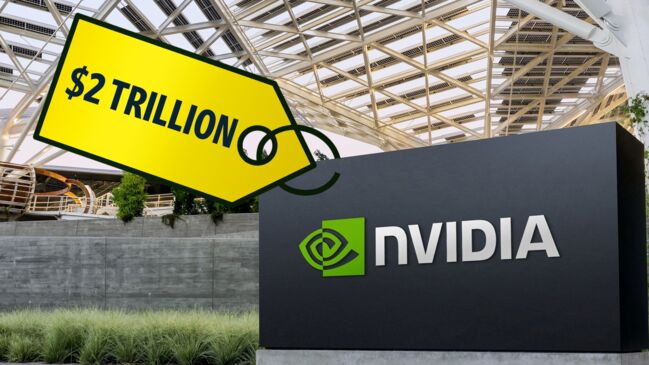Nvidia’s sales triple, signalling AI boom’s staying power
CEO Jensen Huang gives better-than-expected outlook, saying demand remains strong for the company’s chips.

Nvidia delivered a record quarter and signalled that the artificial intelligence boom is still going strong, driving its already meteoric stock above $US1000 a share.
The chips made by Nvidia have powered the rise of artificial intelligence, which is threatening to disrupt virtually every major industry.
Chief executive Jensen Huang declared the beginning of a new industrial revolution where Nvidia was helping turn $US1 trillion of data centres into “AI factories”.
“AI will bring significant productivity gains to nearly every industry and help companies be more cost and energy-efficient,” Huang said.
Nvidia executives also told analysts that demand remained strong for the company’s AI chip as well as for its next-generation product expected later this year.
Revenue in the latest quarter more than tripled from a year earlier to $US26bn, and net profit soared more than sevenfold to $US14.88bn. Both numbers were quarterly records for Nvidia, and beat analysts’ expectations.
Nvidia’s chief financial officer, Colette Kress, said large cloud-computing companies such as Alphabet’s Google, Microsoft and Amazon.com accounted for around 45 per cent of the company’s data centre revenue – more than $US10bn.
Nvidia’s stock price has more than tripled in the past 12 months, sending its valuation above $US2 trillion. The stock rose 6 per cent in after-hours trading on Wednesday following its earnings report, surpassing $US1000 a share – although Nvidia said it would split its stock 10-for-1, effective June 7. It also increased its dividend to US10c a share from US4c, based on the current share count.
Nvidia’s sales turned sharply upward about a year ago, after OpenAI’s ChatGPT wowed users with its ability to generate human-like text.
OpenAI used thousands of Nvidia’s AI chips to create ChatGPT, analysts say, and there are few alternatives for the computation-intensive job of creating and deploying such systems. (The Wall Street Journal’s owner News Corp has a content-licensing partnership with OpenAI.)

Big tech companies and AI start-ups have since been scrambling to buy as many of Nvidia’s chips as possible, leading to a shortage that company executives expect to persist through this year and into next year.
Nvidia’s galloping growth rates are set to slow, owing mainly to the tougher comparisons to last year. The company’s outlook of around $US28bn in sales for its current fiscal quarter, which also topped expectations, is around double its level in the same quarter last year.
Morgan Stanley analysts said in a note this week that the expected deceleration wasn’t a problem for the company’s stock because its valuation compared with its earnings was in line with many of its peers.
Led by Huang, the company started more than three decades ago with a mission to improve computer graphics for gamers. Over the past decade and a half, it has repurposed its graphics chips to be used in other applications including AI, where its approach to computing, involving performing lots of calculations simultaneously, made it a good fit.
The AI boom turned Nvidia’s chips into hot commodities, with tech CEOs jostling over who has more of them. Determined to stay atop the heap, Nvidia plans to launch a new generation of AI chips late this year, following their unveiling in March at a company conference.
The chips, codenamed Blackwell, are to cost more than $US30,000 each, setting the stage for a further surge in sales if the appetite for AI chips stays strong and Nvidia fends off challenges from competitors and regulators.
Huang said the company was producing the chips now and shipments would start in the second quarter ahead of them being in operation in the fourth quarter. Those chips would bring in a lot of revenue this year, he said.
In the lead-up to Blackwell’s introduction, the time it takes to get an H100 AI chip – the most advanced available from Nvidia – has fallen from nearly a year to a number of weeks, partly reflecting Nvidia’s efforts to secure more supplies. Nvidia doesn’t make its chips, but contracts their manufacturing largely to Taiwan Semiconductor Manufacturing Co.
Underlining the demand for the AI chips, Tesla, Meta Platforms and other tech companies have said this year that they plan to buy thousands of them to fuel their AI efforts. Meta expected to have about 350,000 H100s by the end of this year, CEO Mark Zuckerberg said in January.
Demand for both Nvidia’s advanced AI chips and Blackwell was continuing to run ahead of supply, an imbalance that would persist “well into next year”. Huang suggested there was no pause in buying of its chips as customers await the arrival of Blackwell later this year. Demand was growing this quarter, he said, and “everybody is anxious to get their infrastructure online” because they are making money from it.
The Wall Street Journal





To join the conversation, please log in. Don't have an account? Register
Join the conversation, you are commenting as Logout